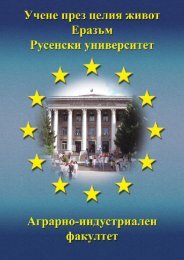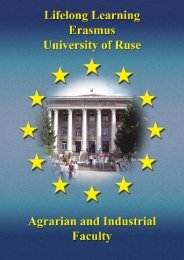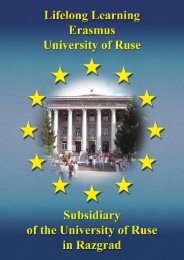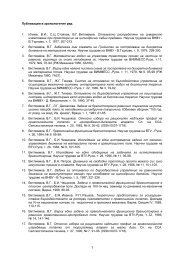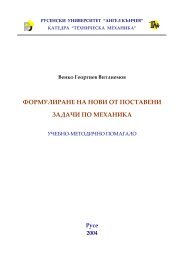Erasmus ECTS Information Package
Erasmus ECTS Information Package
Erasmus ECTS Information Package
Create successful ePaper yourself
Turn your PDF publications into a flip-book with our unique Google optimized e-Paper software.
<strong>Erasmus</strong> <strong>ECTS</strong> <strong>Information</strong> <strong>Package</strong><br />
Faculty of EEEA<br />
3148 Semiconductors<br />
<strong>ECTS</strong> credits: 5<br />
Weekly classes: 3lec+0sem+2labs+0ps+p<br />
Assessment: exam<br />
Type of exam: written<br />
Department involved:<br />
Department of Electronics<br />
Faculty of Electrical Engineering, Electronics and Automation<br />
Lecturers:<br />
Principal Assistant Krasimira Stefanova Shtereva MEng, PhD, Dept of Electronics,<br />
tel.: 888 381, Е-mail: KShtereva@ecs.uni-ruse.bg<br />
Abstract:<br />
The course aims to familiarize the students with the main active semiconductors. It covers the physical principles<br />
of operation, structure, characteristics and the parameters of the discrete elements. The course deals with the<br />
practical application of semiconductors, the ways to connect them in electronic circuits and calculate their working<br />
modes.<br />
Course content:<br />
Physical principles used in semiconductors. Semiconductor diodes. Semiconductor voltage – regulator diodes.<br />
Tunnel diodes. Bipolar transistors: characteristics, parameters of the transistors as quadripole, frequency<br />
characteristics of the transistors; dynamic and key operation mode of the transistor. Field-effect transistors: fieldeffect<br />
transistors with p-n junction. MOS-transistors. Thyristors. Optoelectronics. Principles of microelectronics;<br />
types of integrated circuits; fundamentals of constructing bipolar and МOS – integrated circuits.<br />
Teaching and assessment:<br />
The lectures provide the theoretic aspects of the topics. Each lecture is supported by visual materials such as<br />
slides. Laboratory work involves 4 classes every second week and the whole sub-group does the same<br />
assignment. Each assignment is supported by a report which is defended before the lecturer. The results of<br />
students’ performance are taken into consideration when forming the final mark at the exam. It is written and<br />
involves two questions from the syllabus followed by an oral quiz.<br />
3145 Electrical Engineering II<br />
ЕСТS credits: 5<br />
Weekly classes: 2lec+1sem+1labs+0ps+1ca<br />
Assessment: exam<br />
Type of exam: written and oral<br />
Department involved:<br />
Department of Theoretical and Measuring Electrical Engineering<br />
Faculty of Electrical Engineering, Electronics and Automation<br />
Lecturers:<br />
Prof. Nikola Kolev Armianov, MEng, PhD, Dept. of Theoretical and Measuring Electrical Engineering,<br />
tel.: 888 502, E-mail: narmianov@uni-ruse.bg<br />
Assoc. Prof. Tania Metodieva Stoianova, MEng, PhD, Dept. of Theoretical and Measuring Electrical Engineering,<br />
tel.: 888 502, E-mail: tstoianova@uni-ruse.bg<br />
Abstract:<br />
The Theoretic Electrical Engineering 2 course familiarizes the students with the main methods for analysis of<br />
settled and transient processes in a chain with distributed parameters and in non-linear electric chains and with<br />
the methods of analysis of electric fields.<br />
Course content:<br />
Chains with distributed parameters - main concepts, differential equations of a homogeneous line, settled sine<br />
process in a homogeneous line, input impedance, line with no losses, standing waves. Non-linear electric chains -<br />
constant modes, main laps and methods for analysis, periodic modes, electric chains inertia and non-inertia nonlinear<br />
elements, analysis methods, resonance phenomena, transient processes, methods. Theory of<br />
electromagnetic field – Maxwell’s equations, scalar and vector potential, intensity of electric field, constant and<br />
magnetic fields in polarizing environments, potential fields, equations of Poisson and Laplace, Furrier’s method,<br />
method of mirror images, of complex variable function, polarized ellipsoid, potential and charge equations, partial<br />
capacities, electromagnetic parameters, capacity, inductivity, mutual inductivity, transforming the energy of electromagnetic<br />
field, Pointing theorem, transmitting energy over a two-wire line and transformer connection, alternating<br />
electro-magnetic fields, electromagnetic potentials, D’Alambere’s equations, emitting electro-magnetic waves.<br />
Teaching and assessment:<br />
The continuous assessment is conducted at the laboratory exercises by an oral discussion and submission of<br />
reports. The final assessment is done at the exam (written and oral), which consists of solving problems and<br />
answering questions.<br />
93



